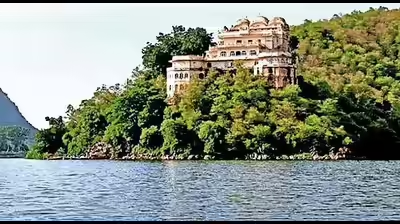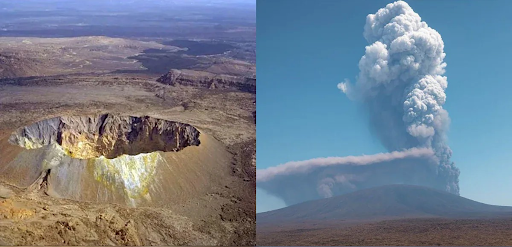





Disclaimer: Copyright infringement not intended.
Maharashtra government has announced a 15-day action plan to remove water hyacinth from Ulhas River responding to citizen activists protests against pollution & emphasizing river conservation efforts.
|
Feature |
Details |
|
Location |
Maharashtra, India |
|
Origin |
Sahyadri Hill Ranges, Raigad District, Maharashtra |
|
Elevation at Origin |
600 meters above mean sea level (M.S.L.) |
|
Length |
122 km |
|
Drainage Basin Area |
4,637 sq km |
|
Flow Direction |
West-flowing |
|
Outfall |
Arabian Sea |
|
Geographical Boundaries |
Main Sahyadri hills on east, westerly offshoots on north & south & a narrow opening to sea on west |
|
Districts Covered |
Thane, Raigad & Pune |
|
Tributary Name |
Type |
Contribution to Catchment Area |
Description |
|
Pej |
Left Bank |
Minor |
Flows through Raigad district |
|
Barvi |
Left Bank |
Moderate |
Supplies water to Barvi Dam |
|
Bhivapuri |
Left Bank |
Minor |
Passes through Karjat region |
|
Murbari |
Left Bank |
Minor |
Seasonal tributary |
|
Kalu |
Right Bank |
Major |
Significant for water supply & irrigation |
|
Shari |
Right Bank |
Minor |
Flows through hilly terrain |
|
Bhasta |
Right Bank |
Major |
One of largest right-bank tributaries |
|
Salpe |
Left Bank |
Minor |
Small seasonal river |
|
Poshir |
Left Bank |
Moderate |
Flows through industrial zones |
|
Shilar |
Left Bank |
Minor |
Local water source |
Kalu & Bhasta Rivers together account for 7% of total catchment area of Ulhas River.
|
Feature |
Details |
|
Estuary Importance |
The estuary of Ulhas River houses several historical ports. |
|
Historical Ports |
Kalyan, Kopri & Shurparaka |
|
Economic Importance |
Industrial & commercial significance due to historical ports |
|
Ecological Importance |
Supports mangroves, fisheries & estuarine biodiversity |
|
Feature |
Details |
|
Location |
Maharashtra, India |
|
Origin |
Near Ambernath, Maharashtra |
|
Length |
~20 km |
|
Flow Direction |
West-flowing |
|
Outfall |
Ulhas River |
|
Districts Covered |
Thane District (Kalyan, Ulhasnagar, Ambernath) |
|
Major Issues |
High pollution levels due to industrial effluents & sewage disposal |
|
Ecological Significance |
Supports local biodiversity but is severely affected by pollution |
|
Factor |
Impact |
|
Industrial Effluents |
Chemical contamination from textile, dyeing & chemical industries in Ulhasnagar & Ambernath |
|
Sewage Disposal |
Unregulated sewage discharge from residential areas |
|
Solid Waste Dumping |
Plastic & garbage accumulation causing water stagnation |
|
Water Hyacinth Infestation |
Leads to oxygen depletion & hampers water flow |
|
Impact on Aquatic Life |
Significant decline in fish population & biodiversity |
|
Impact on Human Health |
Contaminated water leads to health hazards for nearby communities |
|
Initiative |
Description |
|
Maharashtra Government Cleanup Plan |
Announced removal of water hyacinth & pollutants within 15 days |
|
Ulhas & Waldhuni River Action Plan |
Proposed measures for water treatment, sewage management & industrial waste regulation |
|
Citizen Activism |
Local environmental groups protesting & raising awareness about river pollution |
|
Legal Action |
National Green Tribunal (NGT) has intervened to address pollution concerns |
|
Sewage Treatment Plants (STPs) |
Proposed to treat wastewater before it enters river |
|
Parameter |
Details |
|
Scientific Name |
Eichhornia crassipes |
|
Common Name |
Water Hyacinth |
|
Origin |
Native to South America (Amazon Basin), introduced globally |
|
Growth Rate |
Extremely fast; doubles in size within 5-15 days under favorable conditions |
|
Mode of Spread |
Through water currents, human intervention & fragmentation |
|
Preferred Habitat |
Slow-moving or stagnant freshwater bodies (lakes, rivers, ponds, reservoirs) |
Status of Water Hyacinth in India
|
Region/Water Body |
Extent of Infestation |
Impact Severity |
Management Status |
|
Ulhas River, Maharashtra |
High (Thane, Kalyan region severely affected) |
Severe impact on water flow & aquatic life |
Government action plan underway for removal |
|
Waldhuni River, Maharashtra |
High (Pollution & sewage worsen infestation) |
Oxygen depletion, water stagnation |
Part of Maharashtra’s cleanup initiative |
|
Yamuna River, Delhi |
Moderate to High |
Blocks drainage, worsens pollution |
Ongoing mechanical removal |
|
Kaveri River, Karnataka/Tamil Nadu |
Moderate |
Disrupts agriculture & water use |
Manual & chemical control |
|
Dal Lake, Jammu & Kashmir |
High |
Affects tourism & biodiversity |
Controlled harvesting in progress |
|
Chilika Lake, Odisha |
Moderate to High |
Reduces fish productivity |
Government intervention with biological control |
Ecological & Economic Impact of Water Hyacinth
|
Impact Category |
Specific Effects |
|
Ecological Impact |
Depletes dissolved oxygen, blocks sunlight & disrupts aquatic ecosystems |
|
Agricultural Impact |
Blocks irrigation canals & reduces water availability |
|
Navigation Issues |
Hinders boat movement & fishing activities |
|
Health Risks |
Stagnant water promotes mosquito breeding, leading to diseases like malaria & dengue |
|
Biodiversity Loss |
Decreases fish population due to oxygen depletion |
|
Economic Losses |
High cost of removal & loss of fisheries revenue |
Methods of Water Hyacinth Management
|
Method |
Description |
Effectiveness |
Challenges |
|
Manual Removal |
Physical extraction using labor or machinery |
Effective for small areas |
Labor-intensive & costly |
|
Mechanical Harvesting |
Large-scale removal using water weed harvesters |
Faster than manual removal |
Requires high investment |
|
Biological Control |
Use of weevils (Neochetina eichhorniae) & fungi |
Sustainable, cost-effective |
Slow process, needs monitoring |
|
Chemical Control |
Herbicides like glyphosate & 2,4-D |
Quick removal |
Risk of water contamination |
|
Integrated Management |
Combination of manual, biological & mechanical methods |
Most effective approach |
Requires coordination & investment |
Government Initiatives for Water Hyacinth Control in India
|
Initiative |
Implemented By |
Objective |
Current Status |
|
Ulhas & Waldhuni River Cleanup (2025) |
Maharashtra Government |
Remove water hyacinth & restore river health |
In progress |
|
National Plan for Aquatic Weed Control |
Ministry of Jal Shakti |
Nationwide management of invasive aquatic plants |
Ongoing |
|
Dal Lake Restoration Project |
Jammu & Kashmir Government |
Control water hyacinth & pollution |
Active removal operations |
|
Chilika Lake Ecosystem Conservation |
Chilika Development Authority |
Promote biodiversity, control invasive species |
Integrated management approach |
For more such articles, please refer to IAS GYAN
Sources:
|
PRACTICE QUESTION Q. Pollution of rivers like Ulhas as well as Waldhuni has led to severe environmental degradation. Examine role of industrial effluents, urban waste & invasive species in deteriorating river health. Suggest effective mitigation measures. |






© 2025 iasgyan. All right reserved